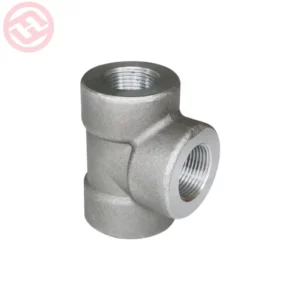When selecting stainless steel forged fittings for a specific piping system, several key considerations should be taken into account.
Here are some important factors to consider:
Material Compatibility: Ensure that the stainless steel forged fittings are compatible with the material of the pipes and other components in the system. Different materials may have varying corrosion resistance properties or require specific joining methods, so compatibility is crucial to avoid galvanic corrosion or other issues.
Pressure and Temperature Ratings: Consider the pressure and temperature requirements of the piping system. Select stainless steel forged fittings with appropriate pressure ratings and temperature capabilities that can safely handle the expected operating conditions without compromising performance or integrity.
Size and Configuration: Determine the required size and configuration of the fittings based on the pipe diameter, system layout, and intended application. Consider factors such as flow rate, space limitations, and the need for specific fitting types such as elbows, tees, couplings, or unions.
Standards and Codes: Adhere to relevant industry standards and codes when selecting stainless steel forged fittings. Standards such as ASTM (American Society for Testing and Materials) or ASME (American Society of Mechanical Engineers) ensure the quality, performance, and dimensional requirements of the fittings.
Corrosion Resistance: Stainless steel forged fittings are chosen for their corrosion resistance properties. Consider the severity of the environment in which the piping system will operate, such as exposure to chemicals, moisture, or high humidity. Select stainless steel alloys with appropriate corrosion resistance to ensure long-term durability.
Installation Requirements: Evaluate the installation process and requirements for the fittings. Consider factors such as ease of installation, accessibility for maintenance or repairs, and compatibility with the joining methods used in the system (such as threading, welding, or socket welding).
Certifications and Approvals: Verify that the stainless steel forged fittings meet relevant certifications and approvals, particularly if your project requires compliance with specific standards or regulations. Examples include certifications from organizations like ANSI (American National Standards Institute) or NSF (National Sanitation Foundation) for applications involving potable water.
Manufacturer Reputation and Quality: Choose stainless steel forged fittings from reputable manufacturers known for their quality and reliability. Consider factors such as the manufacturer’s track record, product warranties, and customer reviews to ensure you’re selecting fittings that meet industry standards and expectations.
By carefully considering these factors, you can select the appropriate stainless steel forged fittings that meet the specific requirements of your piping system, ensuring reliability, durability, and safe operation.
What are the common types of stainless steel forged fittings available in the market?
There are several common types of stainless steel forged fittings available in the market. These fittings are manufactured through a forging process, which involves shaping the stainless steel under high pressure and temperature.
Here are some of the most common types:
Stainless Steel Forged Elbows: These fittings are used to change the direction of flow in a piping system. stainless steel forged fittings They are available in various angles, such as 45 degrees and 90 degrees, to accommodate different piping configurations.
Stainless Steel Forged Tees: Tees have three openings and are used to split or combine the flow of fluids in a piping system. They are available in equal tees, where all three openings are of the same size, or reducing tees, where one opening is larger or smaller than the others.
Stainless Steel Forged Couplings: Couplings are used to connect two pipes of the same diameter. They provide a secure and leak-resistant joint and can be easily disconnected when needed.
Stainless Steel Forged Unions: Unions are similar to couplings, but they allow for convenient disassembly of pipes or fittings. They consist of three parts: a nut, a female end, and a male end. By loosening the nut, the union can be easily disconnected for maintenance or repairs.
Stainless Steel Forged Caps: Caps are used to seal the end of a pipe. They provide protection and prevent the flow of fluids or contaminants in an unused or terminated pipe end.
Stainless Steel Forged Crosses: Crosses have four openings and are used to connect four pipes or fittings in a piping system. They allow for the flow of fluids in different directions.
Stainless Steel Forged Reducers: Reducers are used to connect pipes of different diameters. They provide a smooth transition between pipes with different sizes, allowing for a change in pipe diameter while maintaining the flow rate.
These are some of the most common types of stainless steel forged fittings available in the market. It’s important to select the appropriate fitting type based on the specific requirements of your piping system, such as the desired flow direction, connection methods, and pipe sizes.
